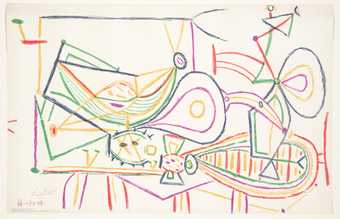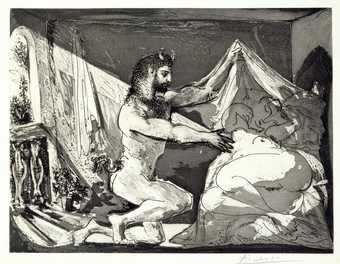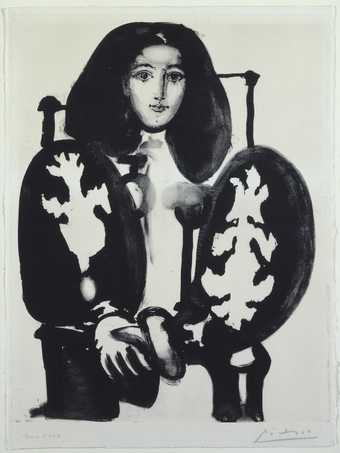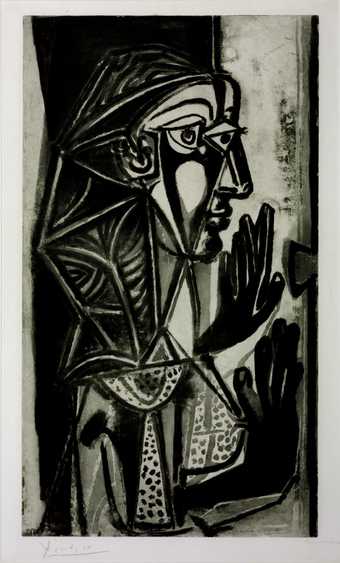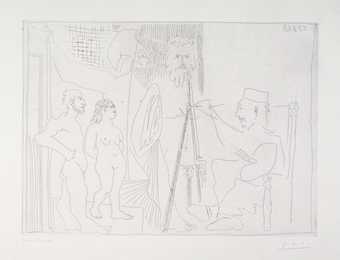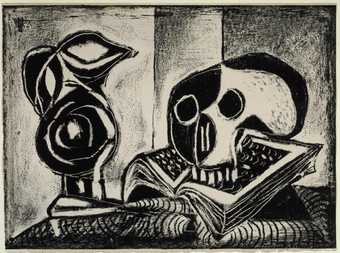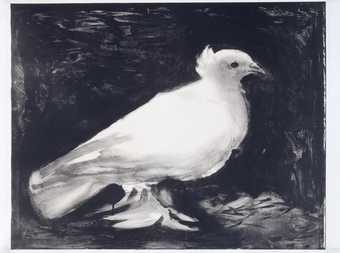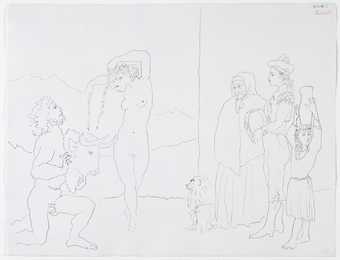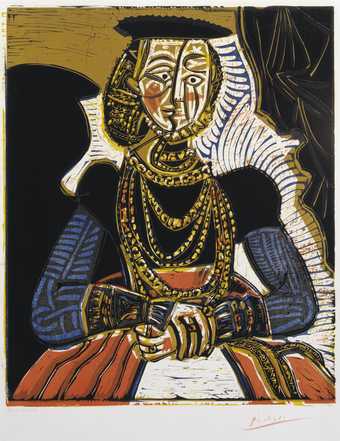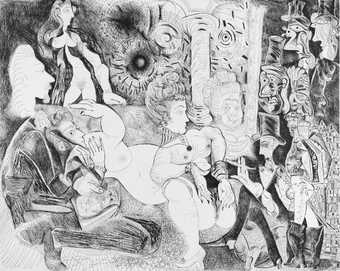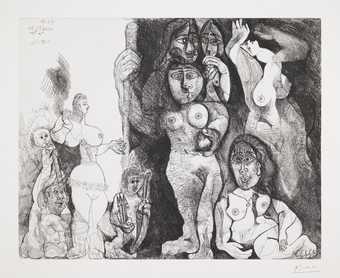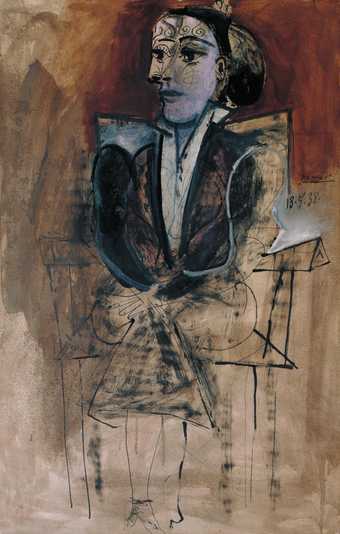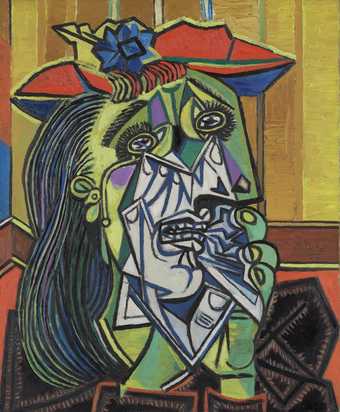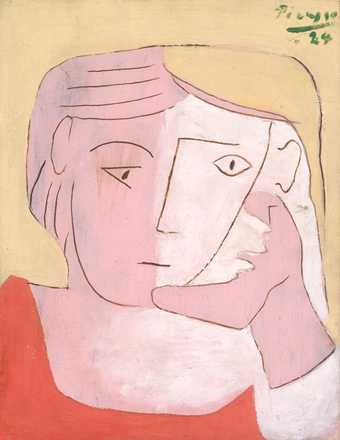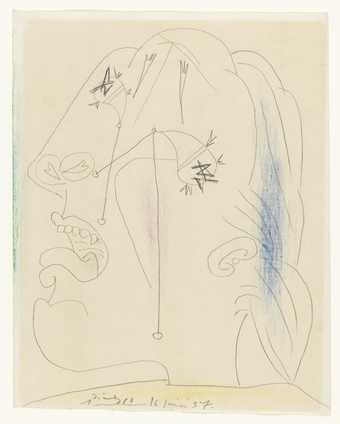
Not on display
- Artist
- Pablo Picasso 1881–1973
- Original title
- Tête de jeune garçon
- Medium
- Lithograph on paper
- Dimensions
- Image: 307 × 227 mm
frame: 530 × 420 × 20 mm - Collection
- Tate
- Acquisition
- Bequeathed by Elly Kahnweiler 1991 to form part of the gift of Gustav and Elly Kahnweiler, accessioned 1994
- Reference
- P11364
Summary
Made on 7 November 1945, Head of a Young Boy is one of the earliest prints that Picasso produced in the atelier of the lithographer Fernand Mourlot in Paris. Having first visited Mourlot’s studio on 2 November 1945, the artist returned to work there every day for four months, arriving before nine o’clock every morning and not leaving until after 8:00 pm (Mourlot 1970, p.11). Between 1945 and 1949 Picasso and Mourlot produced 179 lithographs together (Jean Sutherland Boggs, ‘The Last Thirty Years’, in Roland Penrose and John Golding, eds., Picasso 1881/1973, London 1973, p.202).
The melancholy Head of a Young Boy has been interpreted as Picasso’s nostalgic memory of himself as a young boy. Picasso drew the image with lithographic ink, which he then scraped back with a tool to create rough highlights or details, particularly in the areas of the boy’s hair and clothing. The present print is the third and final state of the lithograph. The first state is the least detailed of the three, the boy’s expression is blank, his face is more rounded and only shaded on the left hand side. In the second state Picasso shaded the head more strongly, defined the mouth and darkened the irises of the boy’s large eyes, rendering them more expressive; he also refined the hair and the contours of the ears. In this final version, Picasso reworked the shading further, softening it in order to achieve a more delicate result.
This lithograph was printed on white Arches wove paper in an edition that comprised eighteen artist’s proofs plus fifty numbered and signed prints published by the Galerie Louise Leiris, Paris, of which this is number forty-four. Louise Leiris gave it as a present to Elly Kahnweiler in 1947, who later bequeathed it to Tate. Elly Kahnweiler was married to Gustav, the brother of the art dealer Daniel-Henry Kahnweiler. Louise Leiris was Daniel-Henry’s long-time assistant and eventually took over the running of his gallery.
Further reading
Fernand Mourlot, Picasso Lithographe, Paris 1970, reproduced p.15
Brigitte Baer, Picasso the Printmaker: Graphics from the Marina Picasso Collection, exhibition catalogue, Dallas Museum of Art, Dallas 1983
Giorgia Bottinelli, ‘Pablo Picasso’, in Jennifer Mundy (ed.), Cubism and its Legacy: The Gift of Gustav and Elly Kahnweiler, exhibition catalogue, Tate Modern, London 2004, pp.88-90, reproduced p.91
Giorgia Bottinelli
August 2004
Does this text contain inaccurate information or language that you feel we should improve or change? We would like to hear from you.
Display caption
Head of a Young Boy is one of the earliest lithographs that Picasso made in collaboration with the Paris lithographer Fernand Mourlot. It has been interpreted as the artist’s nostalgic memory of himself as a young boy. The present print is the third and final state of the lithograph. In the passage from the first to the second state, the boy’s head was shaded more strongly and made more expressive. In this final version, the shading was softened and rendered more delicate.
Gallery label, August 2004
Does this text contain inaccurate information or language that you feel we should improve or change? We would like to hear from you.
Explore
- emotions, concepts and ideas(16,416)
-
- emotions and human qualities(5,345)
- body(4,878)
-
- head / face(2,497)
- boy(1,153)
- Picasso, Pablo(92)
- self-portraits(888)
- nationality(18,601)
-
- Spanish(151)
- arts and entertainment(7,210)
-
- artist - non-specific(2,109)
- artist, ceramicist(117)
- artist, draughtsman(674)
- artist, painter(2,545)
- artist, printmaker(610)
- artist, sculptor(1,668)
You might like
-
Pablo Picasso Composition
1948 -
Pablo Picasso Faun Revealing a Sleeping Woman (Jupiter and Antiope, after Rembrandt)
1936 -
Pablo Picasso Woman in an Armchair No.1 (The Polish Cloak)
1949 -
Pablo Picasso Woman at the Window
1952 -
Pablo Picasso Neo-Classical Painter in his Studio
1963 -
Pablo Picasso Black Jug and Skull
1946 -
Pablo Picasso Dove
1949 -
Pablo Picasso Dance of the Banderillas
1954 -
Pablo Picasso Portrait of a Woman after Cranach the Younger
1958 -
Pablo Picasso Etching: 11, 28 February 1970 3, 16, 30 March 1970 (L.13)
1970 -
Pablo Picasso Etching: 19 February 1970 (L.16)
1970 -
Pablo Picasso Dora Maar Seated
1938 -
Pablo Picasso Weeping Woman
1937 -
Pablo Picasso Head of a Woman
1924 -
Pablo Picasso Weeping Woman
1937

